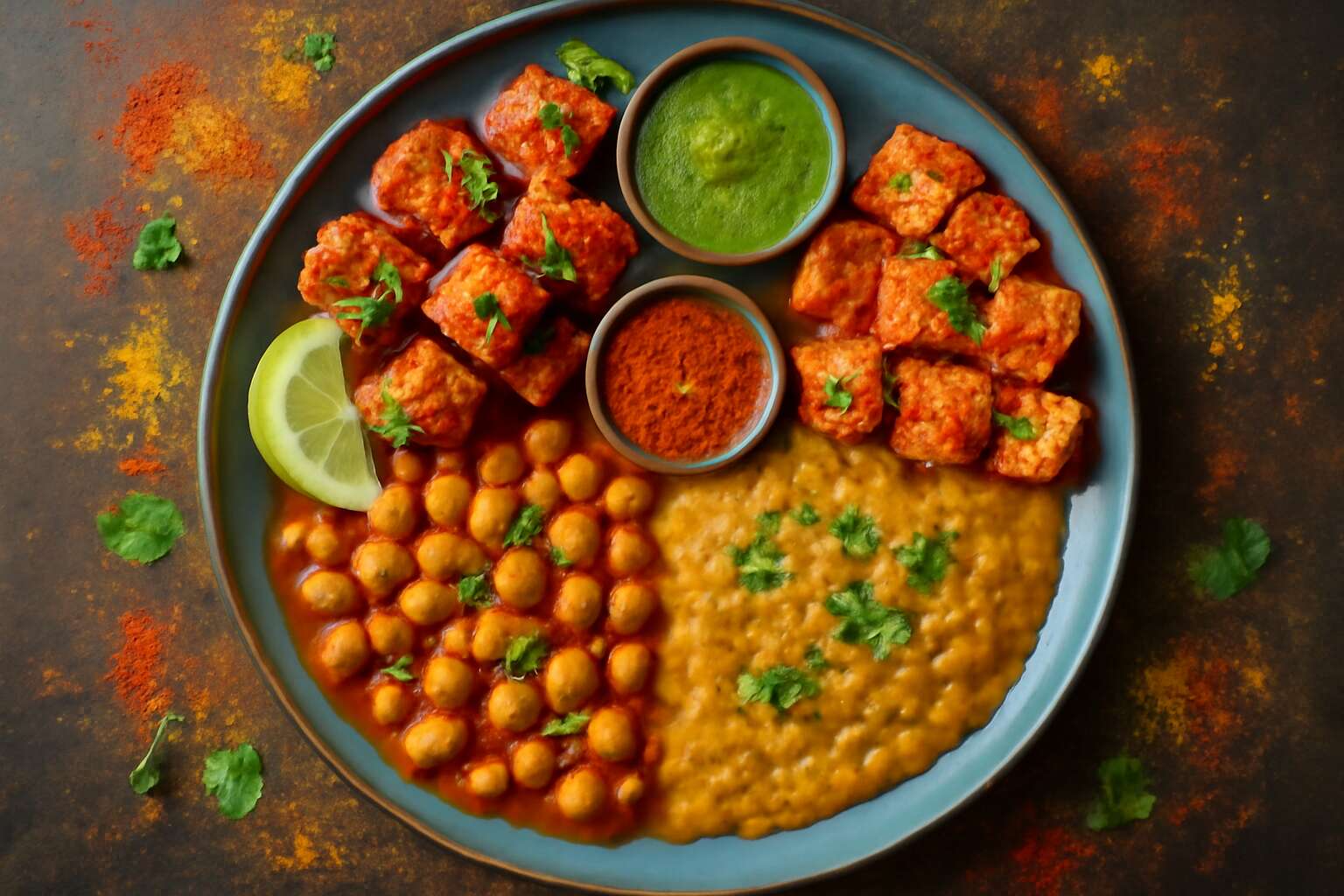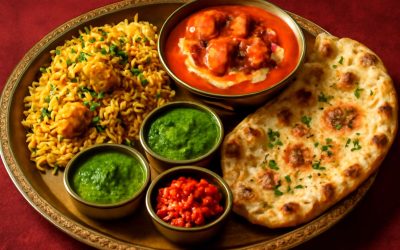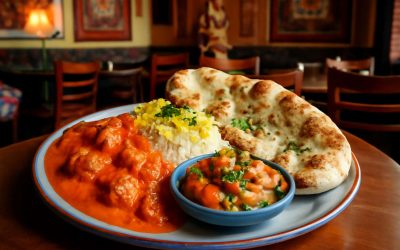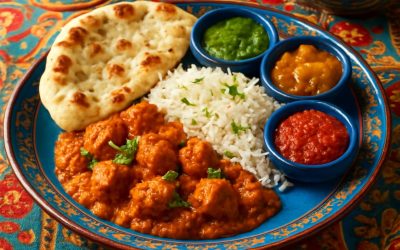Understanding the Protein Content in Indian Cuisine
Overview of Indian Food Composition – Analyzing common ingredients and their nutritional profiles
Indian cuisine is renowned for its vibrant spices and rich flavours, but beneath that colourful exterior lies a fascinating nutritional landscape. When exploring whether Indian food is high in protein, it’s essential to understand the core ingredients that define this culinary tradition. Legumes like chickpeas, lentils, and beans form the backbone of many dishes, offering a substantial protein punch. Additionally, dairy products such as paneer and yoghurt contribute significantly to the overall protein content, making these staples vital for those seeking plant-based or vegetarian sources of protein.
The composition of Indian food reveals a balanced mix of grains, legumes, and dairy, which together create a compelling nutritional profile. Common ingredients like chickpeas in chana masala or lentils in dal provide impressive levels of protein, especially when combined with rice or flatbreads like chapati. For a clearer picture, consider this list of high-protein ingredients in Indian cuisine:
- Chickpeas
- Lentils
- Paneer (Indian cottage cheese)
- Yoghurt
- Tofu (used in some regional adaptations)
While Indian food can be high in protein, the overall content depends heavily on the preparation methods and ingredient choices. The question remains intriguing: is Indian food high in protein? The answer, surprisingly, leans towards yes, especially when traditional recipes are crafted with nutritional awareness in mind.
Role of Protein in a Balanced Diet – Why protein is essential and how Indian dishes contribute
Protein is the unsung hero of a balanced diet, often overshadowed by flashy carbs or fats, yet it’s the building block of muscle, repair, and overall vitality. When it comes to Indian cuisine, the big question is: is Indian food high in protein? Spoiler alert—sometimes yes, sometimes no, but with the right choices, it can be a veritable protein powerhouse. Many traditional dishes are packed with ingredients that deliver impressive doses of this essential nutrient, making Indian food a viable option for vegetarians and meat-eaters alike.
In the grand scheme of a well-rounded diet, protein plays a vital role in maintaining muscle mass, supporting immune function, and even aiding in weight management. Indian dishes contribute to these goals through staples like legumes, dairy, and grains—each offering a different flavour profile and nutritional punch. To truly understand whether Indian food is high in protein, it’s helpful to consider the following:
- Legumes such as chickpeas and lentils are rich sources, often featured in dishes like chana masala and dal.
- Paneer, the beloved Indian cottage cheese, provides a substantial amount of plant-based protein.
- Yoghurt and regional adaptations like tofu further diversify protein options within Indian cuisine.
While some might think Indian food is primarily about spices and flavour, its protein content can be surprisingly robust, especially when traditional recipes are prepared with nutritional mindfulness. So, is Indian food high in protein? The answer hinges on ingredient choices and cooking methods, but overall, it certainly has the potential to be a nourishing protein source that keeps you energised and satisfied!
High-Protein Indian Foods and Ingredients
Legumes and Pulses – Lentils, chickpeas, kidney beans, and their protein content
Indian cuisine boasts an impressive array of high-protein foods, with legumes and pulses playing a starring role. These ingredients are not only staples in countless traditional dishes but are also powerhouses of plant-based protein. Lentils, chickpeas, and kidney beans form the backbone of many hearty, comforting meals, making it clear that Indian food can indeed be high in protein.
The beauty of these legumes lies in their versatility and rich nutritional profile. For example, lentils, often used in dals and soups, deliver around 9 grams of protein per cooked 100 grams. Chickpeas, the star ingredient in dishes like chana masala and hummus, pack approximately 8.9 grams of protein per 100 grams. Kidney beans, featured prominently in curries and salads, provide roughly 8.7 grams of protein per 100 grams. These figures exemplify how Indian culinary traditions seamlessly incorporate potent sources of plant-based protein.
- Lentils
- Chickpeas
- Kidney beans
Together, these ingredients not only satisfy the palate but also contribute significantly to daily protein intake, proving that Indian food can be both delicious and nutrient-dense. The question remains: is Indian food high in protein? Absolutely — especially when you embrace the diverse, protein-rich legumes that are integral to its flavourful tapestry.
Dairy Products – Yogurt, paneer, and other dairy sources rich in protein
Indian cuisine is a treasure trove of high-protein ingredients, and dairy products hold a revered place in this rich tapestry. Creamy yoghurt, velvety paneer, and other dairy sources not only elevate the flavour but also deliver a substantial protein punch. Yogurt, often served as a refreshing side or used as a marinade, provides approximately 3.5 grams of protein per 100 grams, making it an accessible source of nourishment. Paneer, the quintessential Indian cheese, boasts around 18 grams of protein per 100 grams—an impressive figure that underscores its role as a dietary powerhouse.
These dairy staples are seamlessly woven into Indian dishes, offering both taste and nutritional depth. The versatility of paneer lends itself to a multitude of recipes—from hearty curries to delicate snacks—while yoghurt’s tangy charm complements spicy gravies and salads alike. The presence of these ingredients naturally raises the question: is Indian food high in protein? The answer is a resounding yes, especially when dairy forms part of the culinary repertoire.
In fact, incorporating dairy into Indian meals ensures a balanced intake of essential amino acids, supporting muscle growth and overall health. The harmonious blend of dairy and legumes in traditional dishes exemplifies how Indian cuisine masterfully balances flavour with nutrient density, making it a compelling choice for those seeking high-protein foods.
Meat and Seafood – Chicken, fish, lamb, and their role in Indian cuisine
Indian cuisine, renowned for its vibrant spices and complex flavours, also boasts a substantial contribution of high-protein ingredients, especially from meat and seafood. While vegetarian dishes often steal the limelight, the savoury allure of chicken, fish, and lamb remains impossible to overlook. These proteins not only enhance the culinary experience but also serve as essential building blocks for muscle and tissue repair.
In traditional Indian cooking, chicken is frequently featured in curries such as the classic chicken tikka masala, offering approximately 25 grams of protein per 100 grams. Fish, with its delicate texture and rich omega-3 content, is equally prominent in coastal regions, with dishes like fish curry providing around 20 grams of protein per 100 grams. Lamb, often reserved for festive occasions, supplies roughly 25 grams of protein per 100 grams and lends a hearty depth to dishes like rogan josh or mutton stew.
- Chicken
- Fish
- Lamb
These meats and seafood are staples that seamlessly integrate into Indian recipes, elevating both flavour and nutritional value. The inclusion of high-protein meats in Indian cuisine underscores a simple yet profound truth: is Indian food high in protein? The answer is a confident yes—especially when meat and seafood are part of the repertoire, transforming humble ingredients into nutrient-dense culinary delights. Their role in traditional dishes demonstrates how Indian cuisine masterfully balances flavour with the vital need for protein, making it an excellent choice for those seeking a protein-rich diet.
Nuts and Seeds – Almonds, cashews, sesame seeds, and their nutritional benefits
Within the intricate tapestry of Indian cuisine, nuts and seeds emerge as little gems packed with a formidable punch of protein and essential nutrients. Almonds, cashews, and sesame seeds are not merely flavourful adornments; they are powerhouses contributing significantly to the protein content of many traditional dishes. Their inclusion in recipes—whether sprinkled over a fragrant biryani or blended into a luscious chutney—adds layers of texture and depth, elevating both taste and nutrition.
Almonds, for instance, boast a high percentage of protein per serving, making them an ideal snack or ingredient in sweet and savoury dishes alike. Cashews lend a creamy richness, their healthy fats complemented by a notable protein contribution, which supports muscle repair and overall vitality. Sesame seeds, often used in garnishing or as part of spice blends, provide not only a nutty flavour but also a considerable amount of plant-based protein and calcium.
When considering whether Indian food is high in protein, it’s impossible to overlook the role of nuts and seeds. They serve as a vital component for those seeking a plant-based protein source within the rich, diverse landscape of Indian culinary traditions. Their nutritional benefits extend beyond protein, offering fibre, healthy fats, and vital minerals that enhance the overall nutrient density of Indian dishes—truly an elegant testament to how tradition and nutrition intertwine seamlessly.
Popular Indian Dishes Rich in Protein
Vegetarian Options – Dal, chana masala, paneer tikka, and other plant-based proteins
In the vibrant tapestry of Indian cuisine, the question lingers—**is Indian food high in protein?** The answer, woven through centuries of culinary mastery, is a resounding yes, especially when one explores the realm of vegetarian delights. Indian dishes like dal and chana masala burst with hearty pulses and legumes, transforming humble ingredients into protein-rich symphonies of flavour.
Among the most celebrated vegetarian options are paneer tikka, where soft, creamy cottage cheese is marinated and grilled to perfection, offering a plant-based protein punch that rivals the finest meats. These dishes are not only satisfying but also serve as a testament to India’s ingenuity in creating balanced, nourishing meals from plant origins.
For those seeking diversity, a curated list of plant-based proteins includes:
- Dal (lentils)
- Chickpeas in chana masala
- Paneer (cottage cheese)
Each ingredient contributes to the nutritional mosaic, elevating Indian cuisine’s reputation for delivering high-protein options that cater to vegetarian palates and health-conscious individuals alike. The richness of Indian food, therefore, extends beyond mere flavour—it’s a testament to culinary craftsmanship that fosters nourishment and vitality.
Non-Vegetarian Dishes – Butter chicken, fish curry, lamb rogan josh
Indian cuisine isn’t just a feast for the senses; it’s also a powerhouse of high-protein delights—especially when exploring non-vegetarian dishes that pack a nutritional punch. Think of butter chicken, a dish that combines succulent chicken with a rich, creamy tomato gravy, delivering a significant protein boost with every tender morsel. Fish curry, another beloved favourite, offers omega-3 rich seafood that’s both healthy and high in protein, making it a perfect choice for seafood aficionados. Lamb rogan josh, with its aromatic spices and tender meat, stands out as a hearty, protein-rich option that satisfies even the most ravenous appetites.
For those who prefer a more organised approach, here’s a quick rundown of popular Indian non-vegetarian dishes renowned for their high-protein content:
- Butter Chicken
- Fish Curry
- Lamb Rogan Josh
These dishes are much more than flavourful indulgences; they are integral to India’s culinary fabric, showcasing how meat and seafood can seamlessly contribute to a balanced, protein-rich diet. So, the answer to the question—*is Indian food high in protein?*—is a resounding yes, especially when you delve into its non-vegetarian offerings that promise both taste and nutritional value in every bite.
Nutritional Comparison: Indian Food vs Other Cuisines
Protein Density in Indian Dishes – How Indian cuisine compares with other global cuisines
Indian cuisine’s rich tapestry of flavours often sparks curiosity about its nutritional profile, especially when it comes to protein content. Compared to other global cuisines, Indian food offers a compelling balance of plant-based and non-vegetarian sources that can rival and sometimes surpass the protein density found elsewhere. For instance, dishes like dal and chana masala are not only hearty but also packed with plant-based protein, making them excellent options for vegetarians seeking to meet their daily requirements.
When contrasting Indian food with, say, Mediterranean or East Asian cuisines, the emphasis on legumes, dairy, and spices creates a unique nutritional mosaic. Indian dishes often contain a higher concentration of protein per serving, especially when combined with ingredients like paneer, chicken, or seafood. This diverse approach to protein sources reflects the culinary ingenuity of India, where each meal is a colourful mosaic of flavours and nutrients. So, the question remains—**is Indian food high in protein?** The answer lies in the variety and richness of its ingredients, which can make Indian cuisine a surprisingly protein-dense choice for a balanced diet.
Healthier Protein Choices in Indian Cooking – Cooking methods and ingredient selection
Indian cuisine’s intricate tapestry of flavours and textures often conceals a remarkable nutritional depth, particularly in terms of protein content. When contrasting it with other global culinary traditions, such as Mediterranean or East Asian, the nuanced methods of ingredient preparation and selection highlight its potential as a powerhouse of protein. Indian dishes frequently employ ingredients like legumes, dairy, and lean meats, which are prepared through methods that preserve or even enhance their nutritional value.
For instance, slow-cooked curries, tandoori roasts, and simmered stews retain their protein integrity while allowing spices to amplify the bioavailability of nutrients. A notable advantage of Indian cooking is its utilisation of plant-based proteins—lentils, chickpeas, and beans—often combined with grains to create complete amino acid profiles. This strategic pairing not only maximises protein absorption but also makes Indian cuisine a particularly nutritious choice. In essence, when considering whether Indian food is high in protein, the answer is a resounding yes, especially when traditional cooking methods and ingredient choices are optimally harnessed.
Tips for Increasing Protein Intake with Indian Food
Meal Planning and Combinations – Pairing dishes for optimal protein coverage
When it comes to crafting meals that are both delicious and nutritionally dense, understanding how to pair Indian dishes for optimal protein coverage can be a game changer. Indian cuisine, with its rich tapestry of flavours, offers more than just a culinary adventure — it can be a powerhouse of protein if planned thoughtfully. If you’re pondering the question, “is Indian food high in protein,” the answer varies depending on your choices. By combining legumes, dairy, and lean meats strategically, you can elevate your meal’s protein content without sacrificing flavour.
One simple yet effective tip is to pair lentils or chickpeas with dairy-based dishes like paneer or yogurt, creating a wholesome symphony of plant and animal proteins. For instance, a classic chana masala served alongside a dollop of Greek-style yogurt not only enhances taste but also boosts protein intake. To make your meals even more impactful, consider integrating nuts and seeds into your dishes — a sprinkle of sesame seeds or cashews can add texture and protein punch.
- Combine protein-rich ingredients like chicken or fish with vegetarian staples such as dal for a balanced plate.
- Use cooking methods that preserve protein content, like grilling or steaming, rather than frying.
By thoughtfully combining these elements, you ensure your Indian meals aren’t just a feast for the senses but also a strategic move towards meeting your daily protein needs. And yes, when done right, you might just find yourself quietly pondering, “is Indian food high in protein,” with a satisfied smile on your face!
Cookware and Recipes – Adjusting traditional recipes for higher protein content
Indian cuisine, with its vibrant tapestry of spices and aromas, has long captivated the senses. Yet, beneath its colourful veneer lies a potent potential for delivering high-quality protein—if approached with culinary ingenuity. When pondering, “is Indian food high in protein,” many might overlook how traditional recipes can be subtly transformed into nutritional powerhouses. By adjusting cooking methods and ingredient combinations, you can elevate the protein density of your favourite dishes without losing their signature charm.
One of the most effective ways to do this is to incorporate ingredients like paneer, lentils, or fish into your recipes, seamlessly blending plant and animal proteins. For instance, adding grilled fish to a spicy dal or enriching a vegetable curry with a handful of nuts can turn a humble meal into a robust source of nourishment. Cooking techniques such as steaming, grilling, or baking preserve the integrity of these high-protein ingredients, ensuring maximum benefit with minimal nutritional loss.
Consider experimenting with recipes—perhaps turning a traditional tandoori chicken into a protein-rich centrepiece or enhancing a vegetable pulao with extra nuts and seeds.
- Using Greek yoghurt instead of cream in curries
- Adding chickpeas or kidney beans to rice dishes
- Incorporating paneer or cottage cheese into spice-laden stews
These small tweaks can make a significant difference, transforming familiar recipes into a feast that aligns with your dietary goals. Ultimately, with a touch of culinary artistry, you can answer the question—*is Indian food high in protein*—with a confident, affirmative nod, all while indulging in its exquisite flavours.
Incorporating Protein Supplements – When and how to add protein powders or boosts
In the vibrant world of Indian cuisine, the question “is Indian food high in protein” often sparks curiosity. While many associate Indian dishes with rich spices and aromatic curries, their potential as protein powerhouses remains surprisingly underappreciated. Incorporating strategic ingredients and clever techniques can elevate the protein content of traditional recipes without sacrificing their cultural charm.
One effective method is to add protein-rich supplements subtly into your favourite dishes. For example, blending a scoop of unflavoured protein powder into a creamy yoghurt-based curry can boost its nutritional profile seamlessly. This approach is particularly useful for vegetarians who rely heavily on plant-based proteins. When integrating protein supplements, timing is key—adding them during cooking preserves their efficacy, while mixing in at the end prevents any undesirable texture changes.
Similarly, choosing ingredients like lentils, chickpeas, or fish can enhance the protein density of your Indian meals naturally. An unordered list of excellent choices might include:
- Adding a handful of nuts or seeds to rice or vegetable pulao
- Incorporating paneer or cottage cheese into spicy stews
- Using high-protein flours such as chickpea or lentil flour in traditional bread recipes
By thoughtfully pairing these ingredients with traditional cooking methods—steaming, grilling, or baking—you maintain flavour integrity while maximising nutritional value. Whether you’re contemplating, “is Indian food high in protein,” or simply aiming to improve your dietary intake, embracing these small adjustments can have a big impact on your culinary and health goals. After all, Indian cuisine’s true splendour lies not just in its spices, but in its remarkable capacity to nourish.




0 Comments